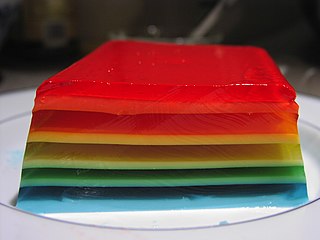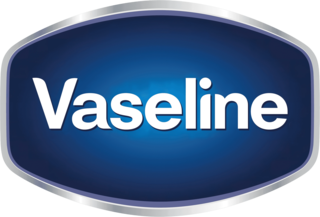
Gelatin desserts are desserts made with a sweetened and flavoured processed collagen product (gelatin). This kind of dessert was first recorded as jelly by Hannah Glasse in her 18th-century book The Art of Cookery, appearing in a layer of trifle. Jelly is also featured in the best selling cookbooks of English food writers Eliza Acton and Isabella Beeton in the 19th century.

Soap is a salt of a fatty acid used in a variety of cleansing and lubricating products. In a domestic setting, soaps are surfactants usually used for washing, bathing, and other types of housekeeping. In industrial settings, soaps are used as thickeners, components of some lubricants, and precursors to catalysts.

Windex is an American brand of glass and hard-surface cleaners—originally in glass containers, later in plastic ones.

Petroleum jelly, petrolatum, white petrolatum, soft paraffin, or multi-hydrocarbon, CAS number 8009-03-8, is a semi-solid mixture of hydrocarbons, originally promoted as a topical ointment for its healing properties. Vaseline has been a well known American brand of petroleum jelly since 1870.

Nonoxynol-9, sometimes abbreviated as N-9, is an organic compound that is used as a surfactant. It is a member of the nonoxynol family of nonionic surfactants. N-9 and related compounds are ingredients in various cleaning and cosmetic products. It is widely used in contraceptives for its spermicidal properties.
Spermicide is a contraceptive substance that destroys sperm, inserted vaginally prior to intercourse to prevent pregnancy. As a contraceptive, spermicide may be used alone. However, the pregnancy rate experienced by couples using only spermicide is higher than that of couples using other methods. Usually, spermicides are combined with contraceptive barrier methods such as diaphragms, condoms, cervical caps, and sponges. Combined methods are believed to result in lower pregnancy rates than either method alone.

Personal lubricants are specialized lubricants used during sexual acts, such as intercourse and masturbation, to reduce friction to or between the penis and vagina, anus or other body parts or applied to sex toys to reduce friction or to ease penetration. Surgical or medical lubricants or gels, which are similar to personal lubricants but not usually referred to or labelled as "personal" lubricants, may be used for medical purposes such as speculum insertion or introduction of a catheter. The primary difference between personal and surgical lubricants is that surgical lubricants are thicker, sterile gels, typically containing a bacteriostatic agent. As of 2015 the personal lubricant market was estimated to be worth at least $400 million.
An excipient is a substance formulated alongside the active ingredient of a medication, included for the purpose of long-term stabilization, bulking up solid formulations that contain potent active ingredients in small amounts, or to confer a therapeutic enhancement on the active ingredient in the final dosage form, such as facilitating drug absorption, reducing viscosity, or enhancing solubility. Excipients can also be useful in the manufacturing process, to aid in the handling of the active substance concerns such as by facilitating powder flowability or non-stick properties, in addition to aiding in vitro stability such as prevention of denaturation or aggregation over the expected shelf life. The selection of appropriate excipients also depends upon the route of administration and the dosage form, as well as the active ingredient and other factors. A comprehensive classification system based on structure-property-application relationships has been proposed for excipients used in parenteral medications.

Reckitt Benckiser Group plc, trading as Reckitt, is a British multinational consumer goods company headquartered in Slough, England. It is a producer of health, hygiene and nutrition products. The company was formed in March 1999 by the merger of British company Reckitt & Colman plc and Dutch company Benckiser N.V.
Calumet Specialty Products Partners, L.P. is a publicly traded U.S.-based company that was incorporated in 1919. It specializes in the manufacture of lubricating oils, solvents, waxes, packaged and synthetic specialty products, fuels and fuel-related products. The company operates 12 production, blending, and packaging facilities across North America. This includes locations in Princeton, Cotton Valley, and Shreveport, Louisiana; Burnham, Illinois; Dickinson, Texas; Muncie, Indiana; and Karns City, Pennsylvania. Calumet's specialized hydrocarbon products are distributed around the world to approximately 2,700 global customers.
Grease is a solid or semisolid lubricant formed as a dispersion of thickening agents in a liquid lubricant. Grease generally consists of a soap emulsified with mineral or vegetable oil.
Surgical lubricants, or medical lubricants, are substances used by health care providers to provide lubrication and lessen discomfort to the patient during certain medical and surgical procedures such as vaginal or rectal examinations. Some example of surgical compatible lubricants are:
A dry enema is an alternative technique for cleansing the human rectum either for reasons of health, or for sexual hygiene. It is accomplished by squirting a small amount of sterile lubricant into the rectum, resulting in a bowel movement more quickly and with less violence than can be achieved by an oral laxative.

Methyl cellulose is a compound derived from cellulose. It is sold under a variety of trade names and is used as a thickener and emulsifier in various food and cosmetic products, and also as a bulk-forming laxative. Like cellulose, it is not digestible, not toxic, and not an allergen.

Hypromellose (INN), short for hydroxypropyl methylcellulose (HPMC), is a semisynthetic, inert, viscoelastic polymer used in eye drops, as well as an excipient and controlled-delivery component in oral medicaments, found in a variety of commercial products.

Vaseline is an American brand of petroleum jelly-based products owned by transnational company Unilever. Products include plain petroleum jelly and a selection of skin creams, soaps, lotions, cleansers, and deodorants.
Harpic is the brand name of a toilet cleaner launched in the United Kingdom in 1932 by Reckitt and Sons. It is currently available in Africa, the Middle East, South Asia, the Asia-Pacific, Europe, and the Americas. The toilet cleaning products marketed under the brand name include liquids, tablets, wipes, brush systems, and toilet bowl and cistern blocks.

Savlon is a brand of antibacterial personal care products with the active ingredients of cetrimide and chlorhexidine gluconate. Commonly sold as a cream, the product range also includes antiseptic sprays, sticking plasters and other antiseptic products.

Hydroxyethyl cellulose is a gelling and thickening agent derived from cellulose. It is widely used in cosmetics, cleaning solutions, and other household products. Hydroxyethyl cellulose and methyl cellulose are frequently used with hydrophobic drugs in capsule formulations, to improve the drugs' dissolution in the gastrointestinal fluids. This process is known as hydrophilization.
Nurofen is a brand name range of pain-relief medication containing ibuprofen made by the British multinational Reckitt. Introduced in 1983, the Nurofen brand was acquired following Reckitt Benckiser's acquisition of Boots in 2005. The brand is primarily marketed and sold in the United Kingdom, other parts of Europe, South Africa, Australia and New Zealand. In 2016 it was the biggest selling branded over-the-counter medication sold in Great Britain, with sales of £116.8 million.














